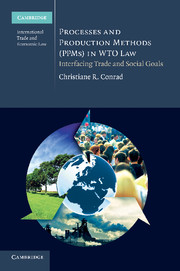Book contents
- Frontmatter
- Contents
- List of figures and tables
- Preface and acknowledgements
- Table of GATT 1947 Reports
- Table of WTO Reports
- List of abbreviations
- Introduction
- I Foundations: the relevance of NPA measures at the interface of domestic regulation, economic globalization and world trade law
- II Legal analysis: reviewing the status of NPA measures de lege lata
- III Outlook: new perspectives on the legal status of NPA measures
- Summary and concluding remarks
- Bibliography
- Index
I - Foundations: the relevance of NPA measures at the interface of domestic regulation, economic globalization and world trade law
Published online by Cambridge University Press: 05 June 2011
- Frontmatter
- Contents
- List of figures and tables
- Preface and acknowledgements
- Table of GATT 1947 Reports
- Table of WTO Reports
- List of abbreviations
- Introduction
- I Foundations: the relevance of NPA measures at the interface of domestic regulation, economic globalization and world trade law
- II Legal analysis: reviewing the status of NPA measures de lege lata
- III Outlook: new perspectives on the legal status of NPA measures
- Summary and concluding remarks
- Bibliography
- Index
Summary
In spite of numerous legal problems related to measures linked to non-physical aspects (NPA measures), the debate on such measures cannot be reduced to a problem of law. The issue is highly complex, due to the relevance of facts central to other disciplines as well. Any attempt to solve the PPM debate based on only one of the relevant disciplines, namely, law, economics, international relations or political science, is bound to fail. A sustainable solution needs to take all aspects of the debate and their implications into consideration. Therefore, the legal status of NPA measures needs to be analysed, taking into account other dimensions. With respect to the agreements underlying the multilateral trading system, implications of economic theory need to be taken into account. Furthermore, since the economic interests of WTO members diverge, and since perceived restrictions on national sovereignty go beyond merely economic issues, the debate has huge political implications. Any solution should address those diverging national and political perspectives and reconcile them. The two chapters forming Part I provide the background relevant to the legal analysis de lege lata, as well as to newer perspectives on the issue as offered in Part III.
- Type
- Chapter
- Information
- Processes and Production Methods (PPMs) in WTO LawInterfacing Trade and Social Goals, pp. 7 - 10Publisher: Cambridge University PressPrint publication year: 2011

